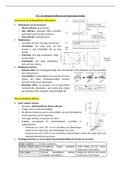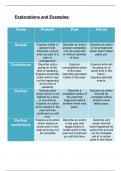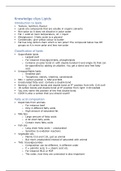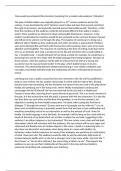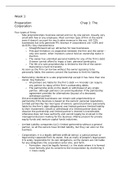MASTER STATEGIC MANAGEMENT
SUMMARY
MICHEL DAGLI
INCLUDING ALL LECTURES, INFOSKILLS,
REF CITE, MANDATORY ARTICLES AND
EXAM 2022
,CONTENTS
Glossary ............................................................................................................................................................... 3
Week 1. ................................................................................................................................................................... 4
Infoskills .............................................................................................................................................................. 4
Infoskills module A .......................................................................................................................................... 4
Infoskills module B .......................................................................................................................................... 7
Infoskills module C .......................................................................................................................................... 8
Infoskills Module D .......................................................................................................................................... 9
Lecture week 1, What is a master thesis? ......................................................................................................... 10
Week 2. ................................................................................................................................................................. 11
REF Cite (APA) ................................................................................................................................................... 11
Lectures week 2 ................................................................................................................................................ 15
Clarifying terms and search methods ........................................................................................................... 15
How to select high quality joural articles ...................................................................................................... 16
The outline of a research proposal ............................................................................................................... 18
Week 3 .................................................................................................................................................................. 20
Lecture week 3 How to read and analyse a paper? .......................................................................................... 20
Tutorial assessment 1 ....................................................................................................................................... 22
Summary: What theory is not ........................................................................................................................... 23
Summary: Construct clarity in theories of management and organization. ..................................................... 25
Conceptual model ......................................................................................................................................... 28
week 4 ................................................................................................................................................................... 29
Lecture week 4 How to develop research ideas ............................................................................................... 29
Problem statement and research questions ..................................................................................................... 31
Summary: Writing a literature review............................................................................................................... 32
Summary: Defining Research Problems: ........................................................................................................... 35
Week 5 .................................................................................................................................................................. 40
Summary: A practical guide for making theory contributions in strategic management. ................................ 40
Summary: Gap-Spotting: The prevalent way of constructing research questions in social science. ................ 44
Week 6 .................................................................................................................................................................. 46
Lecture week 6 How to formulate Problemstatements and research questions ............................................. 46
Summary: The distinctions between theory, theoretical framework, and conceptual framework. ................. 50
Week 7 .................................................................................................................................................................. 54
Summary: Methodological fit in management field research .......................................................................... 54
Midterm 2022 ....................................................................................................................................................... 58
,GLOSSARY
- Empirical:
o bases on what is experienced or seen rather than on theory.
- Scholars
o Scientist (geleerden)
- Difference between construct, concept and variables:
o Concept, construct and variables are treated as a synonym. Construct is something you
cannot directly observe. Concept can be a construct but can also be key findings, the core
ideas from the articles.
- Manuscripts
o handwritten/typed document
- Cognitive:
o Cognitive functions or skills include memory, intelligence, language and concentration.
Thanks to these functions, you are able to absorb and process information and knowledge
- Taxonomie
o is the science of classifying individuals or objects into groups / models
,WEEK 1.
INFOSKILLS
INFOSKILLS MODULE A
Intended audience
Sources of information are created for different audiences, and that affects both their content and layout.
Based on their intended audience, sources can be categorized into three main groups:
- Popular sources:
are intended for readers who do not have specialist knowledge of the subject
- Professional/trade sources:
are written by and for professionals or practitioners in a particular field or industry (e.g., medical
doctors or business executives).
- Scholarly/academic sources:
are written by scholars who are experts in a particular field of study and serve to keep other scholars
in that field up to date on the most recent research findings and ideas.
What is a traditionally published source?
Traditionally published sources come from a commercial or academic publisher.
- Books / e-books
o Popular books
o Professional/trade books
o Scholary books
- Periodicals (regularly: daily, weekly, monthly, or quarterly) (newspapers, magazines)
o Professional/trade periodicals may use the name journal or magazine. They provide content
that's of interest to anyone working in a particular profession or industry (e.g. Law Practice
Magazine, Advertising Age).
o Scholarly periodicals are called journals, with only a few exceptions (such as the scientific
magazines Nature and Science).
What makes a source scholarly?
In order to effectively search for sources for a writing assignment, it's critical that you can quickly identify
scholarly publications. Look for the following characteristics:
- Authors: written by academics who are experts in the field of study. Authors’ names are listed with
credentials/ degrees and places of employment, which are often universities or research institutions.
- Language: advanced vocabulary or specialized language intended for other scholars in the field, not
for the average reader.
But perhaps the most important feature of a scholarly source is:
- Citation: scholarly sources refer to (cite) the origins of information and ideas the author has used to
support his/her argument. (APA)
,Article types published by scholarly journals
- Theoretical articles present new or alternative ways of thinking about a subject, challenge existing
theory, or synthesize recent advances and ideas into new theory.
- Research articles (also called original or empirical articles) report of new research. In the sciences,
economics, and the social sciences this is a highly valued article type. Research articles typically
include an extensive description of how the research was done and what the results mean.
- Review articles (also referred to as 'reviews') summarize the current state of knowledge about a
research topic. Recent reviews are very helpful to quickly get an overview of a topic.
- Case studies are reports in which an individual, event or phenomenon is the subject of study. Purpose
is not to generalize, but to let others know similar things (e.g. a medical condition, job stress) may
occur elsewhere.
- Book reviews are relatively short articles that provide insight and opinion on recently published
scholarly books (monographs). These articles are not considered scholarly even though they are
written by scholars, but they can help identify suitable books that are.
Scholarly articles are composed of the following components:
- Article title
- Abstract (the article's summary containing the key points discussed)
- Introduction or literature review
- Article text/body
o For research articles the article body typically consists of 2 parts: a Methods and Results
section.
- Discussion
- Conclusion (may be part of the Discussion)
- References
Peer review
One of the cornerstones of science is 'peer review', also known as 'refereeing'. Peer review is the process
whereby an article is assessed for quality by his or her peers (experts working in the same field) before it's
published. Articles that have undergone peer review are called 'peer reviewed' or 'refereed'. The peer review
process is used by most scholarly journals.
Types of scholarly sources : (e)books
- Monographs [NL: monografieën / proefschrift] are books on a single specialized subject, usually
written by a single author, but a monograph may also be written by any number of authors.
- Edited books [NL: geredigeerde boeken] are collections of articles/chapters on a subject,
usually written by different authors, gathered by one or more editors.
- Conference proceedings [NL: gebundelde conferentieverslagen]: collections of papers presented at a
conference, congress, or symposium that are traditionally published in book form.
- Textbooks: topically organized books of reference on a certain field of study, specifically for use as a
coursebook for students.
Reference works (also called background sources) are useful to quickly get authoritative facts or information or
an overview of a subject, such as:
- Dictionaries
- General encyclopedias (concise overviews on a wide variety)
- Subject encyclopedias (They provide more in-depth information than a general encyclopedia)
- Handbooks
,'Grey' or 'gray' literature is produced by organizations whose primary activity is NOT publishing. Grey literature
is thus not tied to or controlled by established publishers, and is usually published only online. (Bv. blogs and
social media / articles on news websites / Wikipedia / podcasts)
Source credibility
CRAAP test
CRAAP is the acronym for the five criteria often used to determine whether or not a source is credible and
useful:
- Currency
- Relevance
- Authority
- Accuracy
- Purpose.
See last module of A for examples in info skills.
,INFOSKILLS MODULE B
Different sections on the web
- the surface web (e.g. Yahoo/google)
- the deep web; not freely accessible (like Canvas)
- the dark web; (e.g. criminal activities)
Google Books is Google's project to digitize the world's books and make them available online. The books
primarily come from two sources: publishers and academic libraries
Google scholar, A free search engine that searches across many scholarly research areas and resources, such as
academic publishers, professional societies, institutional repositories, and other online archives.
In-text citations and full citations
Two kinds of citations are used in academic publications: in-text citations and full citations.
- In-text citations are short notations that identify a source. They are used when an idea or evidence
from that source is incorporated into a piece of academic writing.
- Full citations provide all of the information necessary for the reader to find the source to which the in-
text citation points. The complete list of full citations, usually added at the end of the text, is called
'References', 'Bibliography', or 'Works Cited', depending on the citation style used.
Backward and forward citation searching
- Backward citation searching is looking at the full citations included in the reference list of your key
publication and identifying useful ones. The items you find examining your key publication's reference
list are cited publications. Note that backward citation searching is only useful for finding publications
that are older than your key publication.
- Forward citation searching is identifying newer publications on the same or similar topic that cite your
key publication. These are called citing publications
A library database includes information about credible documents such as articles from scholarly journals,
professional journals, newspapers, or magazines. Some library databases also include information about (e-
)books or non-traditionally published sources such as working papers and reports.
,INFOSKILLS MODULE C
Boolean operators
Boolean operators make it possible to combine search terms in a search. There are three Boolean operators:
- And: tell the database to combine search terms so that each search result contains all of the terms.
(cats and dogs).
- Or: tell the database to combine the search terms so that each search result contains at least one of
the terms (cats or dogs).
- Not: tell the database to exclude all terms that follow the operator from the search results (cats not
dogs)
To understand what nesting is, you need to know that databases are programmed to give AND precedence
over OR. This means that terms linked with AND will be searched before those linked with OR. Nesting is a
technique that can be used to override this default search order.
Field searching is searching a specific field of all database records. The default field in a database is usually 'All
Fields' or 'Anywhere'. Other common fields include Author, Title, Source/Publication Name (=journal title),
Abstract, and several topical fields (such as Keywords, Subjects, or Descriptors).
“Phrase searching” is putting multiple-word terms ('exact phrases') in quotation marks. These words will then
be searched next to each other in the exact order in which they were entered into the search box (“global
warming”)
To include various word endings in your search, you can use truncation*, a powerful search technique that
allows you to considerably broaden your search. So if you search on the root word: invest* -- you will retrieve
invest, investor, invested, investing, investment, etc.
A wildcard usually replaces zero to one letters inside the word or at the end of the word. Wildcards are useful
for retrieving alternate spellings (i.e. British vs. American English) and plurals. The question mark (?) is often
used as wildcard symbol: Labo?r – will retrieve labor and labour.
,INFOSKILLS MODULE D
WorldCat Discovery is our library catalog. It includes much of the TiU library content.
- Other:
o Webofscience.com
o Sci-hub.se (all articles in free)
o EconLit (contains a wide range of economic literature)
o Web of science (contains only scholarly materials, including a huge amount of journal articles)
The call number is basically the book's 'address' on the library's shelves. Our call numbers are made up of
letters and numbers and look something like this: SOC B80 49849.
- a 3-letter collection code indicating to which collection the book belongs:
o SOC = Social Sciences
o ECO = Economics
o CIF = Philosophy
- a subject code indicating to which subject category the book belongs:
o B80 = Economic psychology
o R82 = Criminal law
o I18 = Political economy
- a book number which identifies a specific title within the range of books on that subject:
o 49849 etc.
- The TiU library holds a separate collection of books required for TiU courses, called the Student Library
(SB). Call numbers for compulary books begin with the collection code, followed by 'SB' and the first
four letters of the author's last name.
o ECO SB HARR
, LECTURE WEEK 1, WHAT IS A MASTER THESIS?
What is a master thesis?
The best examples to look at when writing your master thesis, are looking at empirical academic papers. These
are often of much higher quality than what is expected from us, but it is good to see the good elements of
these to get ideas for your own thesis. Usually, top core papers get published after a couple of rounds of peer
reviews by other professors, therefore it is difficult to have an academic paper published.
An empirical academic paper consists of:
introduction;
- Why is the topic interesting
- Exact problem statement
- What kind of data and method will be used (briefly described).
o Academic paper: Already answer problem statement
o Master theses do this at conclusion
Theory;
- In-depth overview of existing literature
- The goal of the theory section is to create the best possible research
- Builds up to what will be tested.
o Model/hypotheses
Method;
- Why this kind of data?
- Why this data origin? (Where did we get all this knowledge from)
o Surveys, case studies, interviews: support choice via literature
- Why this method to do research?
Results;
- Actual empirical outcomes
- Tables and graphs
- Use helicopter view to discuss findings.
Discussion and conclusions;
- Answer to the problem statement
- Reflection on unexpected results
- Implications and recommendations for future research.
The last section contains your references.



